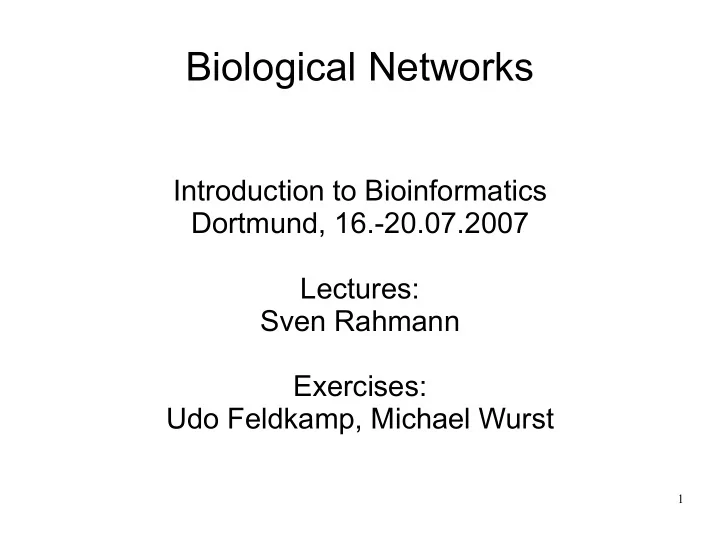

Biological Networks Introduction to Bioinformatics Dortmund, 16.-20.07.2007 Lectures: Sven Rahmann Exercises: Udo Feldkamp, Michael Wurst 1
Different Kinds of Networks ● Networks model interactions ● Mathematical basis: Graphs (as for phylogenetic trees) ● Examples of Networks – social (contact, friendship): Xing, studivz – WWW (dynamically created content?) – biological, chemical, – ... ● Vertices, edges of networks contain information (annotations), e.g., reaction rates, ... 2
Biological Networks ● Transcriptional regulation (protein – DNA) ● Protein-protein interaction ● Protein-ligand interaction ● Metabolomic networks 3
“Random Networks” ● Mathematical models of networks ● “Algorithms” for creating networks according to certain rules – e.g., uniform random networks – “growing a network” ● Mathematical analysis of properties – scale free?: Properties do not change with view level ● Comparison to real networks 4
“Network Motifs” ● Network motifs := Subgraphs in a network that appear more frequently than expected (in a random graph model) ● Idea: All biological networks can be built from a small number of building blocks (motifs) ● Methods from data mining: e.g., frequent itemset mining (items bought together in the supermarket) 5
Pathways ● pathway := part of a network (no unique more specific definition possible) 6
Pathway Databases ● Pathway Resource List http://www.cbio.mskcc.org/prl/index.php ● Expasy ● KEGG ● TransPATH ● BioCyc ● BindDB ● MIPS ● Reactome 7
KEGG ● Kyoto Encyclopedia of Genes and Genomes ● Pathways manually entered, stored as images (.gif) 8
BioCyc (EcoCyc) ● URL: http://www.biocyc.org ● The primary database was EcoCyc (E. coli) ● Several curated pathway/genome databases (PGDB) – each focusing on one organism (ca. 600 organisms) (e.g. HumanCyc, AraCyc) ● MetaCyc database contains non-redundant reference pathways ● Supports – “Pathway Tools” software suite to analyze PGDBs – “PathoLogic” pathway prediction program for new 9 genomes
BioCyc Pathway Tools ● Full metabolic map – paint gene expression data on metabolic network – compare metabolic networks ● Pathways – pathway prediction (PathoLogic) ● Reactions – balance checker ● Compounds – chemical substructure 10 ● Comparison
CoryneRegNet ● Transcriptional regulation in Corynebacteria 11
Recommend
More recommend